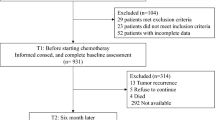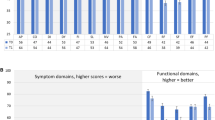Abstract
This study aimed to contribute to the validation of the 30-item Quality of Life Questionnaire developed by the European Organization for Research and Treatment of Cancer Study Group (EORTC QLQ-C30). The sample consisted of 177 cancer patients with heterogeneous diagnoses. A series of scales representing various dimensions of quality of life were tested, including those proposed by the EORTC Study Group. Mokken's non-parametric latent trait model for unidimensional scaling was used as the basic scaling procedure. This model gives coefficients of scalability in addition to reliability coefficients. In terms of scalability measured by Loevinger's H, all EORTC Study Group scales, except the cognitive functioning scale were found to be quite satisfactory. The cognitive functioning scale and the role functioning scale were below the satisfactory level in terms of reliability (internal consistency). In total, our study strengthens the external validity of the EORTC QLQ-C30 and confirms that it may be used on cancer patients with various diagnoses.
Similar content being viewed by others
References
Baum M, Ebbs R, Fallowfield LJ, Fraser SCA. Measurement of quality of life in advanced breast cancer. Acta Oncol 1990; 29: 391–395.
Campbell A, Converse PE, Rodgers WL. The Quality of American Life. New York: Sage, 1976.
Fowlie M, Berkely J. Quality of life—a review of the literature. Family Practice 1987; 4: 226–234.
Næss S. Hva er livskvaliletsforskning? Scand J Behav Ther 1988; 17: 5–27.
Kassa S. Quality of Life and Survival in Patients with Non-small Cell Lung Cancer. Norwegian Cancer Society, 1989.
Sjödén PO. Livskvalitet: definitioner, metodeprinciper och tillämpningsmöjligheter. Scand J Behav Ther 1988; 17 49–62.
Aaronson NK. Methodologic issues in assessing the quality of life of cancer patients. Cancer 1991; 67: 844–850.
Cella DF, Tulsky DS. Measuring quality of life today: methodological aspects. Oncology 1990; 4: 29–38.
Aaronson NK, Bullinger M, Ahmedzai S. A modular approach to quality-of-life assessment in cancer clinical trials. Recent Results Cancer Res 1988; 3: 231–249.
Tchekmedyian NS, Cella DF. Quality of life in current oncology practice and research. Appendix 1. Oncology 1990; 4: 215.
Schag CC, Heinrich RL. Development of a comprehensive quality of life measurement tool: CARES. Oncology 1990; 4: 135–138.
Schipper H. Clinch J, McMurray A, Levitt M. Measuring the quality of life of cancer patients. J Clin Oncol 1984; 2: 472–483.
Priestman TJ, Baum M. Evaluation of quality of life in patients receiving treatment for advanced breast cancer. Lancet 1976; 24: 899–901.
Chambers LW, MacDonald LA, Tugwell P, Buchanan WW, Kraag G. The McMaster health index questionnaire as a measure of quality of life for patients with rheumatoid disease. J Rheumatol 1982; 9: 780–784.
Hunt S, McKenna SP, McEwen J, Williams J, Papp E. The Nottingham health profile: subjective health status and medical consultations. Soc Sci Med 1981; 15A: 221–229.
Morrow GR, Chiarello RJ, Derogatis LR. A new scale for assessing patient's psychosocial adjustment to medical illness. Psychol Med 1978; 8: 605–610.
Padilla GV, Presant C, Grant MM, Metter G, Lipsett J, Heide F. Quality of life index for patients with cancer. Res Nurs Health 1983; 6: 117–126.
Spitzer WO, Dobson AJ, Hall J, et al. Measuring the quality of life of cancer patients: A concise QL-index for use by physicians. J Chronic Dis 1981; 34: 585–597.
Brook RH, Ware JE, Davies-Avery A, et al. Overview of adult health status measures fielded in Rand's health insurance study. Med Care 1979; 17: 1–13.
Bergner M, Bobbitt RA, Carter WB, Gilson BS. The sickness impact profile: development and final revision of a health status measure. Med Care 1981; 19: 787–805.
Zigmond AS, Snaith RP. The hospital anxiety and depression scale. Acta Psychiatr Scand 1983; 67: 361–370.
Bjordal K, Kassa S. Psychometric validation of the EORTC core quality of life questionnaire, 30-item version, and a diagnosis-specific module for head and neck cancer patients. Acta Oncol 1992; 31: 311–321.
Jacoby WG. Data theory and dimensional analysis. Sage University Paper Series On Quanitative Applications in the Social Sciences 07–078. London, Sage, 1991.
Spector PE. Summated rating scale construction. Sage University Paper Series On Quantitative Applications in the Social Sciences 07-082. London, Sage 1992.
Carmines EG, Zeller RA. Reliability and validity assessment. Sage University Paper Series on Quantitative Applications in the Social Sciences 07-017. London, Sage, 1979.
Mokken RJ. A Theory and Procedure of Scale Analysis. The Hague: Mouton, 1971.
Molenaar IW. Mokken scaling revisited. Kwantitatieve Meth 1982, 3: 145–164.
Nunnally JC. Psychometric Theory (2nd edn.). New York: McGraw-Hill, 1978.
Stewart AL, Ware JE, Brook RH. Advances in the measurement of functional status: construction of aggregate indexes. Med Care 1981; 19: 473–488.
Aaronson NK, Bakker W, Stewart AL, et al. Multidimensional approach to the measurement of quality of life in lung cancer clinical trials. In: Aaronson NK, Beckmann J (eds) The Quality of Life of Cancer Patients. New York: Raven press, 1987: 63–82.
Derogatis LR, Lopez M. PAIS & PAIS-SR: Administration, Scoring and Procedures Manual—I. Baltimore: Clinical Psychometric Research, 1983.
Hughes JE. Psychological and social consequences of cancer. Cancer Surv 1987; 6: 455–475.
Aaronson NK. Quality of life research in cancer clinical trials: a need for common rules and language. Oncology 1990; 4: 59–66.
vonEssen L, Sjödén PO. Patient and staff perceptions of caring: review and replication J Adv Nurs 1991; 16: 1363–1374.
vonEssen L, Sjödén PO. The importance of nurse caring behaviors as perceived be Swedish hospital patients and nursing staff. Int J Nurs Stud 1991; 28: 267–281.
Hörnquist JO. Quality of life: concept and assessment. Scand J Soc Med 1989; 18: 69–79.
deHaes J, vanKnippenberg F. The quality of life of cancer patients: a review of the literature. Soc Sci Med 1985; 20: 809–817.
Author information
Authors and Affiliations
Additional information
This study is supported by grants no 89090/001-002 from the Norwegian Cancer Society and by the Faculty of Medicine, University of Trondheim. The study has been evaluated and approved by the Regional Ethical Committee for Medical Research.
Rights and permissions
About this article
Cite this article
Ringdal, G.I., Ringdal, K. Testing the EORTC Quality of Life Questionnaire on cancer patients with heterogeneous diagnoses. Qual Life Res 2, 129–140 (1993). https://doi.org/10.1007/BF00435732
Received:
Accepted:
Issue Date:
DOI: https://doi.org/10.1007/BF00435732




